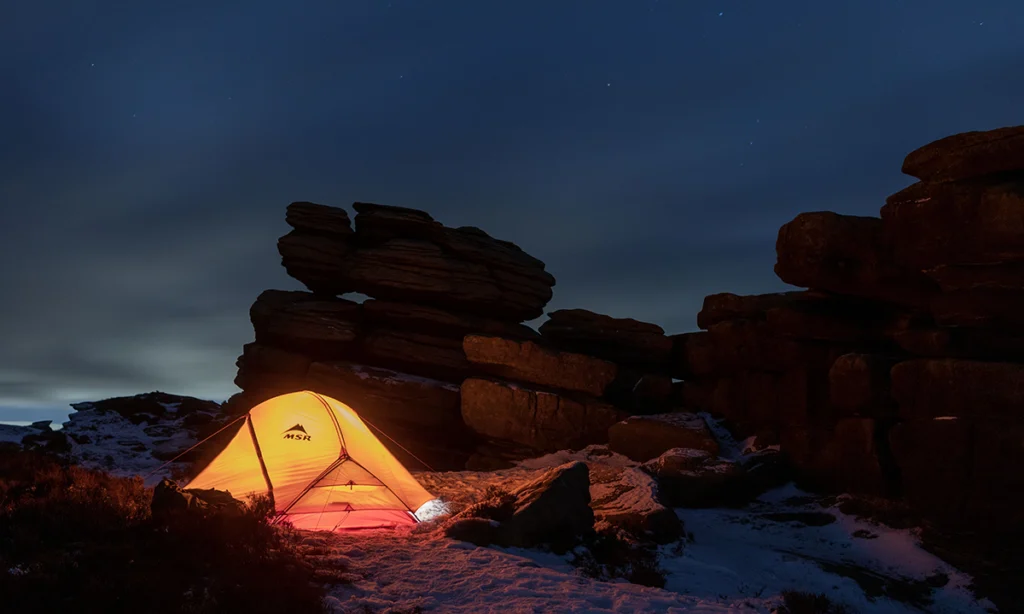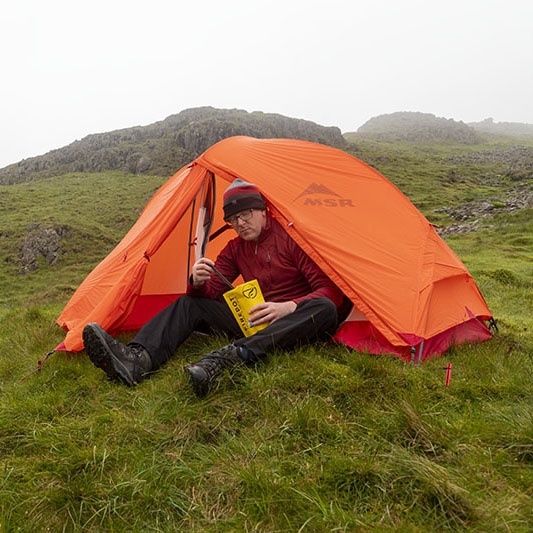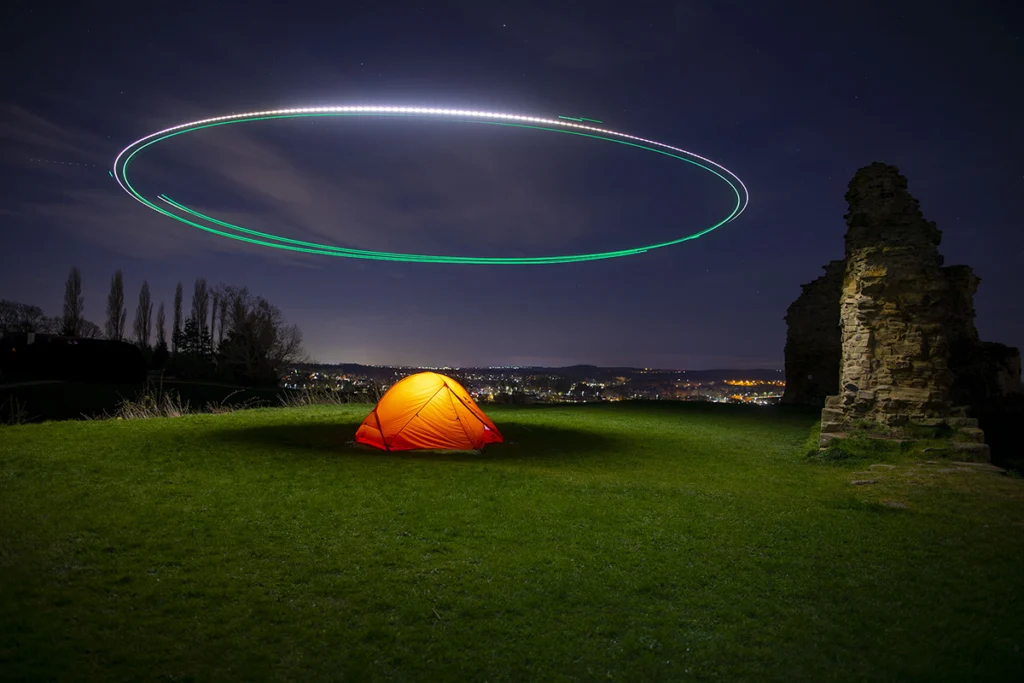MSR Access 2 Review: When Orange Means Business on Lake District Fells
The rain was hammering down on Helvellyn relentlessly, and my bright orange MSR Access 2 was taking the full brunt of it. At 2am, lying in my Rab Mythic 600 sleeping bag whilst heavy precipitation tried its best to find any weakness in the flysheet, I found myself genuinely impressed that this American tent was handling Lakeland weather better than I was handling the situation. The orange glow from my Petzl Tikkina headtorch made the inner feel like a proper sanctuary, and for the first time in months of wild camping across the fells, I wasn’t mentally calculating the cost of a mountain rescue.

The Journey to MSR: A Tale of Puppies, Bribes, and the Three Tents
The story of how I came to own the MSR Access 2 is a bit like Goldilocks and the Three Bears, but with more puppy politics and Yorkshire stubbornness. It all started when the wife developed an obsession with getting a spaniel. After babysitting my old man’s dog during lockdown, she was properly smitten. Problem was, COVID had sent spaniel prices through the roof—we’re talking £3,500 for a decent pup, which was completely out of the question for a Yorkshire lad with a mortgage.
But my wife, being able to talk the birds from the trees, hatched a plan that would make Machiavelli proud. First, she sweet-talked my dad into letting her breed a litter with his bitch. I was absolutely not having my kitchen turned into a puppy nursery for 8-12 weeks, but she knew exactly how to get me onside—by purchasing me a new tent. Clever woman knew the way to a landscape photographer’s heart.

This tent purchase became my own Goldilocks moment. My first wild camping tent was the Vango Force Ten Polar Pro 3—far too big and heavy for the mountain photography I wanted to do. Like Goldilocks finding Papa Bear’s porridge too hot, this tent was simply too much. At over 4kg and packing down to the size of a small shed, it was about as suitable for mountain photography as wearing my Rab Mythic 600 sleeping bag to the pub. That tent eventually fell to bits near Buttermere (literally—the flysheet separated from the inner during heavy rain), and Go Outdoors thankfully gave me a full refund.
Determined not to repeat my mistake, I went completely the other direction and bought the Terra Nova Laser Comp 2. Like Goldilocks finding Baby Bear’s porridge too cold, this tent was far too small. Barely room to sit up, nowhere to cook properly, and storage space that would challenge a minimalist monk. The pole sleeve system drove me absolutely mental—trying to thread poles through sleeves whilst wearing my Rab Baltoro Gloves in sub-zero conditions was an exercise in frustration that tested both my patience and my vocabulary.
So when the wife’s puppy bribery scheme presented itself, I knew exactly what I needed: something in the middle. Light enough to carry up to remote locations for overnight time-lapse sessions, but spacious enough to serve as a proper base camp during those brutal 16-hour winter nights when you’re waiting for the perfect shot. Like Goldilocks finding the porridge just right, I needed a tent that would be just right for serious landscape photography.
What I Absolutely Love About the MSR Access 2
Build Quality That Inspires Confidence: The first thing you notice when unpacking the Access 2 is that everything feels substantial without being overbuilt. The 20D ripstop nylon flysheet with 1200mm DuraShield coating has a reassuring heft to it, whilst the poles—MSR’s proprietary Easton Syclone composite—feel like they could double as tent pegs in a pinch. At 1.88kg including all accessories, it’s heavier than true ultralight options but lighter than most 4-season alternatives. After eighteen months of use across Lake District fells, Peak District moors, and Yorkshire Dales wild camping spots, there’s not a single sign of wear that concerns me.
Weather-Worthy Performance: This tent handles typical British mountain conditions well. The low profile and crossed-pole design provide decent stability, and the guy-out points are positioned where you need them. When combined with my standard camping kit—Therm-a-Rest NeoAir XTherm sleeping mat and the reliable warmth of my Rab Mythic Ultra Down Jacket as a pillow—it creates a comfortable mountain refuge even when Lakeland weather turns properly wet.
Sensible Interior Layout: At 213cm long and 127cm wide, there’s enough space for me plus all my camera gear without feeling cramped. The floor area of 2.69 square metres genuinely feels spacious for one person, and adequate for two if you don’t mind cosy living. The two doors are genuinely useful rather than just a marketing tick-box—one for entry/exit, the other for gear storage or emergency escape. The dual vestibules provide 1.62 square metres of combined storage space, generous enough for my Jetboil Flash cooking system and muddy Salomon Quest 4 Gore-Tex boots, with room left over for my camera bag when weather turns properly nasty.
Colour Choice That Actually Matters: The orange isn’t just for show—it’s genuinely practical. On overcast days when you’re trying to spot your camp from a distance (usually whilst carrying too much camera gear), that distinctive colour is a godsend. It photographs well too, which matters when you’re documenting trips for gear reviews or just want camp shots that don’t look like everyone else’s.
Setup Speed When It Counts: In proper mountain conditions, when your hands are going numb and visibility is dropping, the Access 2 goes up without drama. The colour-coded poles and clips are visible even in poor light, and the whole process takes less than five minutes even when you’re working alone. This has been crucial during those “should have started earlier” photography missions when sunset waits for nobody.
Packability for Photography Trips: At 1.88kg packed weight, it’s not ultralight, but it packs down to a sensible 46cm x 15cm that doesn’t dominate my Karrimor SF Sabre 75 expedition pack. More importantly, it fits alongside my photography kit—camera body, tripod, and essential accessories—without forcing awkward compromises on what gear makes the cut. The minimum weight (without stakes and stuff sack) drops to 1.64kg, which matters when you’re gram-counting for overnight landscape photography missions.
Proper Mountain Tent Features: The internal pockets are positioned where you’ll actually use them, the gear loft keeps essentials accessible, and the zips run smoothly even when the tent’s under tension. Small details like the reflective guy-line attachment points and robust stake-out loops show this tent was designed by people who actually use their own products.
Where the Access 2 Falls Short
Weight Penalty for Solo Adventures: Whilst 1.88kg isn’t excessive for a 4-season tent, it’s noticeable when you’re hiking to remote locations for overnight time-lapse shoots. During a recent photography mission on the Central Fells, carrying the tent plus my camera gear meant careful planning of what equipment was essential. My Alpkit Vayper base layer was earning its keep during the cold night shoots.
Inner-First Pitching Challenge: The Access 2 pitches inner-tent first, which sounds minor until you’re trying to set up in horizontal rain. Unlike many 3-season tents that let you pitch the flysheet first, you’re committed to getting the inner up before any real weather protection kicks in. This has caught me out a couple of times during unexpected weather changes, forcing some undignified scrambling whilst wearing my Rab Cinder Downpour Jacket inside the tent.
Price Point Reality: At £714, this isn’t entry-level kit, and the performance gains over mid-range options aren’t always obvious until conditions turn properly nasty. For fair-weather camping, you’re paying for capability you might never fully use.
Pack Size Versus True Ultralight Options: Whilst it packs reasonably well, genuinely ultralight tents will always beat it for space efficiency. When every cubic centimetre matters in your pack, the Access 2’s robust construction comes with a volume penalty.
Real-World Performance for Landscape Photography
Lake District – Great Langdale Time-lapse Sessions: During overnight photography sessions focused on capturing star trails and sunrise sequences over the Langdale Pikes, the Access 2 proved its worth in classic Lakeland conditions. Pitched at around 400m elevation with my usual kit—Rab Baltoro Gloves for the early morning camera work, Benro Tortoise tripod setup ready outside the vestibule—the tent handled everything from sideways rain to sudden temperature drops without missing a beat. The orange colour was particularly useful for navigation when returning from camera positions around Stickle Tarn in the dark.
Yorkshire Dales Photography Sessions: Using the tent for overnight stays whilst capturing time-lapse sequences from Pen-y-ghent, Ingleborough, and Whernside, I appreciated its durability under frequent setup and breakdown. The robust pole design handled assembly when I was knackered after long nights of photography, and the spacious vestibules meant I could properly organise my gear—camera batteries in one pocket, Sawyer Mini water filter and CamelBak Crux reservoir in another—without creating chaos.
Peak District Landscape Photography: During overnight sessions documenting sunrise time-lapses from Kinder Scout, Bleaklow, and Black Hill, the Access 2 became a reliable mobile base. The interior space accommodated my camera gear and laptop for reviewing sequences, whilst the stable structure meant I could leave equipment organised inside without worry. My Flex Tail Gear Pump X proved invaluable for both inflating the sleeping mat and providing ambient lighting for gear organisation during night shoots.
Lake District Storm Testing: A memorable overnight session on the Helvellyn range during unsettled weather provided the ultimate stress test. With winds gusting over 60mph and near-continuous precipitation, the tent’s storm-worthiness became genuinely important rather than just marketing speak. Paired with my Snugpak Sleeper Expedition sleeping bag for the extreme conditions, it created a comfortable refuge that let me focus on capturing dramatic weather time-lapses rather than worrying about shelter failure.
Time-lapse Photography Missions: Using the tent for overnight landscape photography sessions, I appreciated features that aren’t obvious until you’re spending entire nights outdoors. The dual vestibules meant I could keep camera equipment separate from wet clothing, whilst the interior organisation options—gear loft, corner pockets, attachment points—proved essential for keeping batteries warm and memory cards organised during long time-lapse sequences.
Integration with Complete Four-Season System
The Access 2 works brilliantly as the final piece of my four-season landscape photography setup. The combined vestibule space of 1.62 square metres perfectly accommodates my Jetboil Flash cooking system—there’s enough headroom to use it safely under cover, with plenty of ventilation to prevent any buildup of fumes. The essential brew kit that keeps morale high during long photography sessions fits comfortably alongside, and the generous space means I can cook properly even when the weather’s grim outside.
The tent pairs excellently with my complete cold-weather system. Inside, there’s perfect space for my Rab Mythic 600 sleeping bag and Therm-a-Rest NeoAir XTherm sleeping mat combination. The 107cm peak height means I can sit up properly to review time-lapse sequences on my laptop or organise camera gear without developing permanent neck strain, whilst the interior organisation—gear loft, corner pockets, attachment points—keeps everything accessible during those long winter nights.
One of the Access 2’s standout features is its excellent condensation management. The adjustable vents at each end allow fine-tuning of airflow depending on conditions, and I’ve found that with proper ventilation, condensation is rarely an issue even during those brutal temperature swings that plague British mountain photography. The limited mesh panels keep the warmth in whilst the venting system moves enough air to prevent the steamy interior that plagues many four-season designs.
For photography-specific needs, the tent’s stability means I can leave my Canon 5D Mark IV and Lowepro PhotoSport Backpack PRO 70L AW III organised inside overnight without worrying about vibration or movement affecting delicate equipment. The colour-coded interior organisation helps keep track of memory cards, batteries, and filters even when working by headtorch light during those essential pre-dawn gear checks for time-lapse sequences.

Genuine Alternatives Worth Considering
Hilleberg Niak: The Swedish gold standard for mountain tenting, offering superior build quality and legendary durability. At 2.4kg, it’s only marginally heavier than the MSR, but the fabric quality and attention to detail are genuinely better. The main advantage here is you’re getting incremental improvements in build quality whilst spending less than the Access 2. If you’re planning serious expeditions or simply want buy-once-cry-once reliability, the Niak offers better value for money.
Vango F10 Xenon UL 2: A properly British alternative that offers 80% of the Access 2’s performance at significantly less cost. At 1.9kg, it’s marginally heavier but packs smaller, making it ideal for photography trips where every gram counts. The build quality isn’t quite MSR standard—expect more care needed during setup and breakdown—but for three-season use in typical British conditions, it’s genuinely capable. The substantial cost savings could fund other essential kit upgrades.
Big Agnes Copper Spur HV UL2: The American ultralight option that prioritises weight savings over ultimate durability. At 1.13kg, it’s significantly lighter than the Access 2, which matters enormously when you’re hiking to remote locations for overnight photography sessions. Costing substantially less than the MSR, the trade-off is reduced storm-worthiness and longevity—expect to replace it sooner, but for fair-weather time-lapse missions where weight trumps everything else, it’s genuinely appealing.
Terra Nova Laser Comp 2: I actually owned this tent previously but found it too fragile for my needs. At 1.27kg, it’s genuinely ultralight, and the British design handles UK conditions well when treated carefully. However, the single-skin construction and minimal guy-out points meant I was constantly worried about failure in serious weather. Costing significantly less than the Access 2, it’s perfect for experienced users who prioritise weight above all else, but demands more skill and care than the bombproof MSR approach.
Conclusion
The MSR Access 2 has earned its place as my go-to mountain shelter through simple reliability. It’s not the lightest tent I could buy, nor the most spacious, but it consistently delivers the fundamental requirement of keeping me dry and comfortable regardless of what British weather throws at it. For landscape photography adventures where equipment protection matters as much as personal comfort, the robust construction and sensible layout make it worth the weight penalty.
Would I buy it again? Absolutely, and I’d stick with the orange version—I loved that distinctive colour the first time I saw it, and it’s proved both practical and professional-looking in the field. At £714, it represents a significant investment that needs careful justification. The performance is genuinely excellent, but you’re paying premium prices for incremental gains over alternatives that cost substantially less.
The real test of any gear purchase is whether you trust it completely, and after more than fifty nights in conditions ranging from balmy summer evenings to proper Scottish storms, I never question whether the Access 2 will do its job. That confidence is worth every penny of the purchase price, and probably explains why MSR continues to dominate the serious mountain tent market despite fierce competition.
For landscape and time-lapse photographers, or anyone who takes their mountain shelter seriously, the Access 2 delivers the reliability that lets you focus on capturing the perfect sequence rather than worrying about whether you’ll stay dry overnight. At £714, it’s undeniably expensive, but if you’re frequently out in challenging conditions for overnight photography sessions and can justify the cost over several seasons of use, the confidence it provides makes it worthwhile kit rather than just another tent.
SCORE
For more Reading on the MSR ACCESS 2
